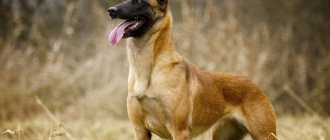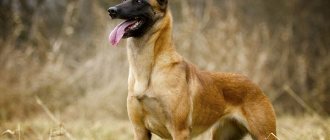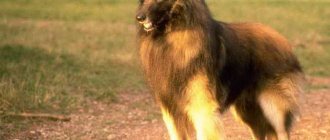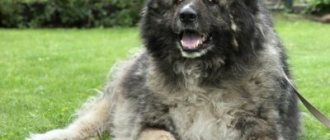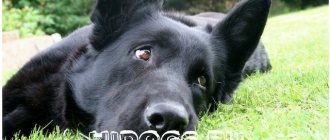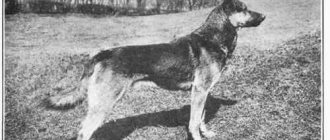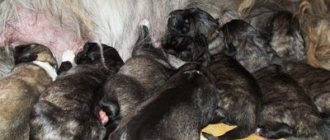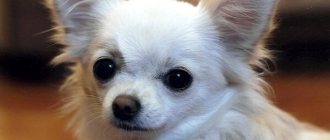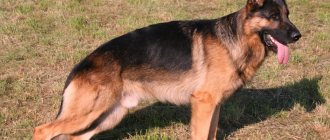| Origin: | Belgium |
| Usage: | herding, universal service dog, companion dog |
| Color: | black, fawn, with or without mask depending on the species |
| Dimensions: | height at withers 58-62 cm, weight 20-30 kg |
| Lifespan: | 10-12 years |
The Belgian Shepherd is a harmonious and proud dog with excellent working characteristics. As a result of selection, the breed was divided into 4 varieties - Groenendael, Malinois, Laekenois and Tervuren. Animals have different appearances and differ in some character traits. But they are all loyal, smart and resilient. They should not be owned by inexperienced dog breeders, as well as people who prefer a passive lifestyle. For everyone else, the pet will become a loyal friend and reliable comrade.
Breed standard
The Belgian Shepherd is a harmonious combination of elegance and power. The animal has a lean physique and well-developed muscles. The standard clearly defines the optimal physical parameters for males and females:
- height – 62 and 58 cm, respectively. The height at the withers may be 2 cm less than indicated or 4 cm more;
- weight – 25-30 kg for males, 20-25 kg for females.
Official description of the breed (FCI standard No. 15):
| Become | Characteristic |
| Head | Dry, harmonious. The distance from the tip of the nose to the stop is approximately equal to the length of the skull or slightly longer. The stop is moderately pronounced. |
| Muzzle | Medium length, wedge-shaped, widening from the lobe to the head. The bridge of the nose is parallel to the skull. |
| Ears | Compact, triangular, high-rise. When alert, they look strictly straight. |
| Eyes | Medium, slightly slanting, elongated. The darker the color of the iris, the better. The expression is attentive, inquisitive and lively, which is clearly visible in the photo of Belgian Shepherds. |
| Nose | Only black coloring of the lobe is acceptable. |
| Jaws | Large white teeth are hidden behind brightly pigmented lips. A scissor bite is preferred, but a straight bite is also acceptable. |
| Neck | Direct, very powerful. Expands as it approaches the body. There is no suspension. |
| Torso | The shape is close to a square - the length is approximately equal to the height at the withers. The chest is voluminous, descending to the elbows. The back and lower back are straight and muscular. The belly is moderately tucked - it does not sag, but does not seem excessively dry. |
| Tail | Medium size, saber-shaped. When the Belgian Shepherd is relaxed, it hangs down calmly. Thanks to it, the dog can masterfully change the direction of movement without slowing down. |
Representatives of the breed have thick and dense fur, which perfectly protects from bad weather. However, animal fur has different lengths, growth directions and colors. Because of this, the Belgians were divided into 4 varieties. You can find out what each of them looks like from the description below and see in the photo.
Belgian Shepherds exhibiting obvious physical or behavioral abnormalities are subject to disqualification.
Groenendael
The animal species is named after the city in which the breeder engaged in the selection of Belgian Shepherds lived.
This is a long-haired dog with smooth, straight fur. Shorter hairs are located on:
- skull;
- muzzle;
- paws;
- inside the ears.
A collar and frill are visible on the neck and chest. On the animal’s hips the fur is very long and forms “pants”. The tail is also well let down, slightly widening towards the tip. The standard recognizes Belgian Groenendael Shepherds as exclusively black in color.
Laekenois
Wire-haired dog with coarse fur. The coat does not adhere to the body, but looks disheveled. The length of the hair is about 6 cm, slightly less on the face, head and paws.
This variety of Belgian Shepherd is characterized by a fawn color with a poorly defined black pattern on the head and tail.
Malinois
A short-haired variety of Belgians, named after the city of Malines. The smallest hairs are located on the head, paws, and inside the ears. The remaining parts of the animal's body are covered with longer fur. A characteristic collar is formed on the neck, and on the back of the thighs there are peculiar “pants”.
The standard allows for the only color of this variety of Belgian Shepherd - fawn with a black pattern on the body and a mask of a similar color. Moreover, the mask should cover the lips and eyelids, forming a single black space. The pattern represents hair with black tips. This rule also applies to the Belgian Tervuren variety.
Tervuren
The long-haired type of Belgian Shepherd is considered the most elegant. The structure of the animal's fur is identical to the Groenendael. Color: preference is given to fawn dogs with black markings, but other colors are acceptable - gray with black. The main color should be clearly expressed, the pattern should stand out clearly.
All varieties of Belgian Shepherds may have a small amount of white hair on the chest and toes.
Belgian Shepherds - history of the breed
The Belgian Shepherd (BO) breed originates from the shepherd dogs that ran around Europe in large numbers in the 17th, 18th and 19th centuries. The first mention of dogs similar to modern BOs dates back to 1650. Mostly they were shepherd dogs (in the sense of herding dogs). Sheepdog in English SHEEP DOG is a sheep dog or a dog with a sheep (with a flock of sheep). These were dogs of different colors, sizes and coat textures. They had one thing in common - they were great at helping herd herds: they gathered animals in a heap, and if necessary, they could protect them from wild animals, and they also protected the owner from uninvited aggressive two-legged “animals.”
On September 29, 1891, shepherd lovers organized a club for shepherd lovers in Belgium (Belgian Shepherd Dog Club or Club du chien de berger belge). The first project of this club was an exhibition at the veterinary school in Cureghem, which took place that year on November 15th. 117 dogs were presented at the exhibition. After examination, only 40 of them were recommended for further breeding by Professor Reul. By April 3, 1892, the first detailed BO standard was ready. However, the dogs were still very diverse, and the standard did not have any official status.
As a result, it was not until 1901 that the first BOs were registered in the Royal Saint-Hubert Society Stud Book (LOSH).
Over the next few years, breed enthusiasts worked actively to unify the type and “correct the errors” of the original 1892 standard. It can be argued that by 1910 the type and nature of the BO had been established. The color variety was still long and hotly discussed, but the morphology, character and suitability for work did not cause disagreement.
At first there were three color options: -For dogs with long hair - only black. This is Groenendael; -For dogs with short hair - red-brown color. Nowadays we call such dogs Malinois; -For dogs with hard hair - gray color. This type of BO is called laekenois.
By approving only three color options in the standard, many valuable dogs were excluded from breeding. Owners of dogs whose color did not correspond to the above three organized their own club and bred dogs of all shades of brown, gray and black. In 1885, these clubs merged and the standard changed. Today, the following four varieties of BO are bred: -Groenendael (Groenendael) - long-haired, black in color; -Laekenois (laekenois) - wire-haired, gray or red-brown in color; -Malinois (Malinois) - short-haired, red-brown in color; -Tervueren (Tervuren) - long-haired, red-brown in color.
By the way, the USA and Canada under the name of the Belgian dog mean only the Groenendael, while the Malinois and Tervuren are considered separate breeds, and the Laekenois is not recognized at all.
Next, we will consider in more detail the history of the creation of all four types of BO.
GROENENDAEL
Groenendael got its name from the small town. And even more precisely from the owner of the cafe, who decided to perpetuate the name of his cafe “Grunendaal”. Around 1879, this cafe owner discovered a pure black puppy in the litter. It was called Piccard d Uccle. Piccard subsequently had puppies with a long-haired black female named Petite. One of them, DUC DE GROENENDAEL, is considered the ancestor of all purebred Groenendaels. DUC and his littermates Pitt, Baronne, Margot, Berger were exhibited in 1891 and together with Piccard and Petite produced more than 30 Groenendael dogs. Later, the Groenendael breeding center moved to another city, but the name remained.
LAEKENOIS
Laekenois received its name from the royal castle of LAEKEN. In addition to the noble Belgians, in the castle there lived simple shepherds who for many years bred special shepherd dogs with coarse, very coarse short hair. The ancestor of the breed is considered to be the wire-haired male VOS. His children Toma and Voss II were similar to him in coat structure and color. From Voss II and the gray female Mera came the gray Bezouf. Bezouf mated with his own mother Mera. This mating resulted in Bover Sus. As can be seen from the pedigree, too few puppies with pronounced hereditary characteristics appeared in the litters - hard hair, brown or gray color.
The history of Laekenois can be called unhappy. The Laekenois was not as popular or attractive as the Groenendael and Tervuren and never had the good reputation of a working dog like the Malinois. In addition, due to frequent inbreeding, Laekenois have serious health problems: hemophilia, dysplasia, infertility (in males and females), osteochondrosis and innate aggressiveness. To refresh the blood, matings with Malinois are periodically carried out, but still the Laekenois remains the smallest variety of BO to this day.
MALINOIS
Named after the small town of Malines. The Malines breeders needed a good working dog, conformation was not important. Therefore, when breeding purebred Malinois, different types of BO were used. The origins of the Malinois are the brown tabby female DIANE, daughter of the shorthaired male VOSS (see Laekenois pedigree) and the tabby male LIESKE. Diane was also used with the tabby male SAMLOS (its origin is unknown). From this mating a short-haired, but not wire-haired male, TOMY, emerged - he is considered the ancestor of the Malinois. Also known are the short-haired red-haired male DEWET with a dark mask and the short-haired dark brown male without a mask TJOP, who participated in the creation of the Malinois.
TERVUEREN
Breeder of the first BO similar to the Tervuren Mr. F. CORBEEL lived in the city of TERVUEREN and, accordingly, the name Tervuren comes from the name of the city. Mr. Corbeel had a female POES and a male TOM. They were both longhaired dark mahogany with black tips. Nowadays these black tips are called charbonage and are a distinctive feature of the Tervuren. In 1885, puppies were born from TOM and POES. One of them, the female MISS, was mated with a black long-haired male DUC DE GROENENDAEL. They gave birth to a long-haired red-brown male with black hair ends. He was named MILSART - he is considered the ancestor of the Tervuren. Thus, Tervurens are the result of four dogs: Piccard d Uccle x Petite (parents of Duc de Groenendael) and Tom x Poes (parents of Miss).
War of flowers
The problem of another color appeared very soon. The problem escalated into a "war" after the first BO exhibition in 1891, when Professor Reul recommended certain (only three) colors for breeding. In 1914, the long-haired bitch CREOLE was shown at an exhibition in Brussels. She had an excellent body, she could be called the "prototype of the breed", but she had a gray color, darker on the collar and with black ends of the hair. The breeders were perplexed: why a dog of excellent type should be excluded from breeding because of a color not specified in the standard. As a result of these discussions, Creole won the exhibition, but the discussions did not stop.
The First World War suspended the “war of flowers”, because many war fighters died. BOs were used on the battlefields as orderlies, carriers of shells, messengers... In 1920, the club made concessions and, in order not to lose the breed and restore the livestock, allowed the use of long-haired gray dogs for breeding. The greatest interest in gray BOs arose in 1965 - 1970, when the male Milko du Parc de I Hay won all exhibitions. Milko comes from Groenendael. His grandson Vici des Hauts de Bievre increased his grandfather's successes and even had three World Champion titles. Vici was born in 1972 to gray parents Quarry van Nekkerberg Ter Leie (son of Milco) and Riane du Donjon De Vincennes. Vici became the father of many, many beautiful puppies and his name now appears in many pedigrees.
All this would not be worth telling if gray was included in the standard. But that did not happen. The last “battles” on the fronts of the “war of flowers” broke out between Belgium and France. Belgium requires that gray dogs be excluded from breeding, since the population has been restored and there is a large selection of good dogs of standard colors. And in France, the latest “squeak” is BO in gray and silver-steel shades.
Since 1989, BOs of gray shades have been officially allowed for breeding, provided that an expert judge gives the dog a positive assessment. That is, everything is left to the judge. Naturally, French judges place gray dogs as winners, but Belgian judges often do not notice gray dogs in the ring at all. Thus, the same gray dog can have CAC and very good ratings. chorus simultaneously.
If we approach the “color war” from a genetic point of view, it becomes clear that the gray heritage is present in many pedigrees. The rest is a matter of taste.
Features of behavior, character, education and training of BO
If your BO does not fulfill some of your requests or commands, this does not mean that she is lazy, stupid or harmful, the dog just did not understand you. It was you who incorrectly explained to her or did not clearly explain what exactly you want from her. With proper upbringing and training, a BO can do a lot. By nature, BO is an intellectual, so you need to treat her firmly, but kindly, strictly, but not rudely. It will not be possible to explain something to the dog by force; she will be offended, leave you, and you will lose contact with the dog for a long time.
All Belgian owners are delighted with two aspects when raising a dog - firstly, its unpretentiousness, and secondly, its ability to work. I will dwell in more detail on two features of this breed.
Unpretentiousness of BO. Any weather conditions - wind, rain or downpour, snow or hail, heat and scorching sun - are perceived by the Belgian Shepherd as a gift from God, with a bang, the dog is ready for active work in any situation. Unpretentiousness is also expressed in the fact that the care of the coat of any type of BO is minimal: brushing and removing the undercoat during the molting period. Even before shows, it is not recommended to wash the dog unless it is very dirty. Regarding exhibitions, it should be noted that the breed developed focusing on the working qualities of dogs, therefore even very beautiful specimens with health problems were excluded from breeding. Therefore, BO is in excellent health.
The exception here is Laekenois. This type of BO can be called a genetic freak or, more mildly, a game of genes. Laekenois puppies are extremely unviable, and many adults die suddenly at 2 - 3 - 4 years of age. Experts make a diagnosis: “died of old age.” As paradoxical as it sounds, the combination of genes in the Laekenois is unstable, so at 3 years old the dog can die a natural death from old age. This explains the very small number of Laekenois BOs in the world.
Noting unpretentiousness and adaptability to any weather conditions as the advantage of BO, it should be noted that complexity follows from this advantage. Namely: BO needs constant work and active movement. She is absolutely not suitable for the role of a sofa dog. Even living in a cramped city apartment is a problem for BO. But if the problem of movement can be solved with walks and games, then the problem of loads and work should constantly and acutely worry the owners of sports equipment. It should be noted that in Russia, potential dog owners are paying more and more attention to BO. And where it comes to choosing between German and Belgian shepherds, preference is increasingly given to BO. And not in vain: after all, while maintaining all the working qualities of a shepherd, the Belgian shepherd is more intelligent, has a refined appearance and is much lighter in weight, and, therefore, consumes less food, which in our conditions is of no small importance, and differs from the BUT in its “increased cross-country ability” i.e., having a lower (compared to BO) total weight and a more compact, elegant structure, BO will pass, climb, jump…. where BUT cannot cope due to its structure and weight.
BO performance. The performance of the BO is legendary. Many owners note this feature of BO. Living in a family, BO chooses the weakest of all family members (as a rule, these are children) and shepherds him, following relentlessly, protecting and even predicting his actions. How interesting it is to teach something BO!! She eagerly grabs onto any job. And if something doesn’t work out, she will try again and again and won’t leave you behind until she succeeds the way you want. For example, BO can be taught to walk on his hind legs, pick apples from a branch, and even bring eggs from the chicken coop. Yes, BO is stubborn. BO is a creative workaholic!
Today it is rare to work as BO shepherds. And that’s why the man came up with many different and interesting jobs for BO. BOs work in the police, customs, Russian SOBR and American Special Forces, rescue dogs, guide dogs. BO are also unsurpassed leaders in canine competitions: rings, agility, freestyle, flyball. But the most important advantage of a BO is a companion dog: smart, helpful, intelligent and intelligent, sociable, but at the same time brave, strong, resilient and hardworking.
Character
Belgian Shepherds are active, energetic, and always ready for work and action. At the same time, these dogs have a very balanced and calm character. Animals are not characterized by cowardice and unmotivated aggression. Thanks to these qualities, pets cope excellently with any function assigned to them - be it herding or guarding property.
Different types of Belgian Shepherd differ slightly in temperament:
- Groenendael - unpretentious, ready to perform various tasks. Often involved in work in emergency services;
- Laekenois – more docile and peaceful than other representatives of the breed;
- Malinois are prone to dominance. These animals have more developed guarding and herding instincts;
- The Tervuren is a born watchdog. Does not attack without good reason, but in the event of a clear threat, acts fearlessly and decisively.
Belgian Shepherds are very loyal and love their owners with all their hearts. Dogs are wary of strangers, but do not show aggression if they do not see danger.
Belgians require constant attention - pets suffer greatly from lack of communication. Due to lack of contact with the owner, animals become nervous and withdrawn.
You should not allow your pet to take the position of leader. There is only one leader in the pack - a man. If behavior problems arise, you should immediately show the dog who is boss.
Personality of the Belgian Shepherd
Each of the four varieties of the Belgian Shepherd has character traits unique to it. Moreover, an inexperienced dog breeder will not be able to understand this right away. Only when comparing shepherds is it easy to see their differences in behavior or attitude towards the environment.
The Groenendael is best suited for the role of a security guard. These animals are very attentive and have well-developed intuition. In case of danger, the dog will notify everyone by barking loudly. She will not be afraid of a stranger, but will be very wary of him in the presence of family members.
The character of the Belgian Shepherd Laekenois combines playful and serious qualities, the desire to move mountains and jump into the owner’s arms. For the sake of protecting the owner or members of his family, the Belgian is ready to tear to pieces the enemy. The direction of Laekenois behavior will depend on the goal set by the person. She can become an excellent guard or a wonderful companion.
The Malinois is a balanced individual, capable of following on the heels of its beloved owner. She understands human intonations well. This variety of Belgians needs constant attention from humans and suffers greatly when it is lacking.
Tervuren is known for its lively, temperamental character. He is ready to immediately enter the game and give chase. Chewed slippers or broken pots will be the result of loneliness, which the Tervuren will not be able to calmly endure.
Considering the characteristics of each branch of the Belgian Shepherd, breeders call their common traits:
- autonomy, independence in decision making;
- increased sensitivity to yelling or criticism;
- good adaptation to new living conditions;
- desire to dominate other animals.
The owner of the Belgian should show maximum love and patience so that the pet can show the best traits inherent in its type.
Socialization
A Belgian Shepherd puppy begins to be socialized as early as possible, otherwise the pet will grow up uncontrollable and will not be able to adequately interact with the outside world. A couple of days after the baby appears in the house, they take him outside, introduce him to relatives and other people, and accustom him to the noise of the city. The dog must learn the rules of residence, know when it is possible to play, and when it is better not to disturb the owners.
The Belgian Shepherd dog breed requires professional training. If the owner has little experience, it is better to give the puppy to a dog handler who can raise him properly.
Belgian Shepherds are highly trainable and remember commands right away. But we cannot stop there. The acquired skills need to be constantly reinforced, so they continue to work with the pet even after it has completed a basic training course. Treats are used as reward. The pet is also generously praised for any action performed correctly.
Dogs of this breed do not tolerate rough treatment - the owner needs to be persistent, but patient. To show your pet that he is doing something wrong, it is enough to change the intonation to a rude one, or, in extreme cases, pull the leash. If you don’t plan to raise your pet into a service dog, you should find something else for him to do. An agility course is perfect for these purposes.
An untrained Belgian Shepherd is dangerous to others. Such a dog does not know how to analyze current events, which is why it can rush at a person if there is an imaginary threat.
Belgian Shepherds easily find contact with other pets if the owner pays enough attention to the dog. But in relation to small animals, a manifestation of the hunting instinct is possible. It is better if four-legged friends meet in childhood.
The Belgian Shepherd will selflessly protect the child, but will not tolerate disrespectful treatment. A well-mannered pet will not injure the baby, but will not play with him either. The dog will be more interesting with teenagers - you can run with them and frolic in the fresh air. To avoid misunderstandings between the Belgian and children, they should be told in advance about the rules of behavior with animals and dog body language.
Nervous system
If the Malinois is properly raised as a puppy or teenager, a genetically good dog will become obedient. And inept handling will lead to the development of hysteria, fears and aggression. And all because of the low threshold of excitability. In other words, a lower level of stimulus is needed for the animal to begin to reflex. At the same time, they have a quick reaction, which, with the proper approach, will be a plus for the owner. German Shepherds have “nerves of iron.” You can leave children to play with them, because they will tolerate the pranks of kids. They may well become excellent nannies for them. However, the same cannot be said about the Belgians. The leadership qualities, instincts and jealousy of the Malinois towards the owner can be a risk to the lives of children.
How to choose a puppy
It is better to purchase Belgian Shepherd puppies from trusted kennels, rather than from private individuals. You should first learn about the characteristics of the breed, the nuances of maintenance and care. Due to its large size, it is difficult for an animal to live in an apartment - the best option would be a private house with a spacious plot.
Before purchasing, be sure to meet the puppy's parents. And not just look at the photos, but communicate in person. Belgian Shepherds can have temperamental flaws that are easily inherited. Mentally stable dogs are more likely to produce similar offspring.
The smaller the litter, the stronger and more resilient the babies will be.
A healthy Belgian Shepherd puppy:
- active;
- curious;
- not cowardly;
- moderately well-fed.
The baby should have shiny fur without an unpleasant odor, clean eyes, ears and nose.
A responsible breeder will tell you in detail about the diet and education of Belgian Shepherd puppies, and will stay in touch even after the purchase. If a person remains silent and tries to sell the kids quickly, this is a reason to think about it. Most likely, there is something wrong with the litter, so it is better to refrain from purchasing the animal and look for another nursery.
To participate in exhibitions, they buy grown-up juniors who are 9 months old. At this age, it is already possible to evaluate the animal’s exterior, compliance with the standard, and identify temperamental deficiencies. Active and charismatic dogs achieve greater success.
There is no need to believe a breeder if he says that all his puppies are show puppies. One litter can contain both high-quality Belgian babies and outright purebreds.
Varieties and standard of Belgian Shepherds
As mentioned above, in our time there are 4 breeds of Belgian Shepherds:
- Malinois;
- Laekenois;
- Tervuren;
- Groenendael.
The FCI adopts a common standard for all BO breeds. They differ only in their coat and colors.
Table: general standard of Belgian Shepherds
| general description |
|
| Important proportions |
|
| Dimensions |
|
| Head |
|
| Body |
|
| Tail |
|
| Limbs |
|
| Movements |
|
| Leather |
|
There is one standard for all BOs
Table: standard coat and colors BO
| Variety | Breed | Wool | Color |
| Longhair | Groenendael |
| Black solid |
| Tervuren |
| ||
| Shorthair | Malinois |
|
|
| Wire-haired (rough-haired) | Laekenois |
|
|
The standard distinguishes BOs only by coat types and colors
Features of maintenance and care
The Belgian Shepherd does not require specific care. It is adapted to life on the street - its dense coat protects it from cold, heat, and precipitation. But a pet can be kept in an apartment if it is provided with a long walk.
You can't keep animals on a chain - they become aggressive.
Grooming
The coat of Belgian Shepherds requires special attention. The nuances of care depend on the type:
- Groenendael and Tervuren - the animal’s fur is combed a couple of times a week. When the time comes for seasonal molting, the procedure is carried out daily. Also, dogs must remove the hair between their paw pads so that the pet does not slip on smooth surfaces;
- Malinois are the easiest pets to care for. They are brushed once a week. When your pet sheds – every 2 days;
- Laekenois - to keep the dog's coat in order, wire-haired dogs need to be trimmed. The Belgian's coat grows slowly, so there is no need to cut your pets' hair.
Otherwise, care for Belgian Shepherds is standard. Dogs have their ears and teeth cleaned and their eyes wiped. If the pet only walks on soft ground, its claws should be trimmed.
Belgians are given bath treatments as needed, but not more than once every 30 days. Due to regular washing, the wool loses its natural sheath and loses its shine.
Walk
Belgians are very active. Regular walks lasting 2-3 hours are a necessary condition for their maintenance. It is not enough for an animal to simply walk along the street or park. It is better to visit special areas where you can practice commands or play outdoor games. In crowded places, your pet must be muzzled.
Cycling enthusiasts often combine walks with bike rides - the dog will happily run after its owner.
Feeding
Belgian Shepherds are given either ready-made premium or super-premium food for large dogs, or natural food. In the latter case, it is important to properly balance the animal’s diet so that the pet receives all the necessary vitamins and minerals.
The Belgian menu includes:
- lean meat and offal;
- sea fish;
- porridge (buckwheat, rice, rolled oats);
- vegetables, fruits, herbs;
- eggs (preferably quail);
- fermented milk products (kefir, fermented baked milk, cottage cheese).
Belgian Shepherd puppies are given food 8 times a day at regular intervals. Gradually the number of feedings is reduced to two. The dog must eat in a specially designated place. Handouts from the human table are contraindicated for Belgians - you cannot follow your pet’s lead, no matter how pitifully he asks.
When feeding natural food, vitamin and mineral supplements are included in the Belgian Shepherd's menu. There is no need to skimp on food - eating low-quality food causes serious health problems.
Products that are strictly prohibited from being introduced into the Belgian diet include:
- any salty, spicy, fried, smoked, pickled food;
- confectionery;
- fatty meat or lard.
Regardless of the menu chosen, the dog should always have access to clean water.
If it is not possible to prepare food for the Belgian Shepherd separately, the animal should be switched to ready-made food.
Without proper physical activity, Belgians quickly gain excess weight, which is fraught with many health problems. Therefore, the owner must carefully monitor the animal’s diet and provide the pet with appropriate exercise. However, you cannot force a dog to run immediately after feeding - the pet’s digestion will be disrupted.
Care and maintenance
- Like all medium and large dogs, the Malinois needs to run at least 6-7 km per day for proper bone development. It is important for them to interact with other people and pets in order to develop tolerance towards strangers.
- There is practically no smell from these dogs, but you can treat the premises with special solutions that can be purchased at any pet store.
- It is important to regularly vaccinate your pet and carry out deworming procedures.
- In addition, it is necessary to examine the eyes and ears and wipe them daily with a damp swab; brush teeth as they become dirty (give special cords for chewing and removing tartar), trim nails once every 2-3 weeks with special scissors. In the summer, it is important to treat your pet for fleas and ticks: drip medications onto the withers, put on collars.
Nutrition
Good quality nutrition for Malinois is the key to a strong skeleton and beautiful coat. The breeder can choose dry food, in which case it is necessary to buy only premium class. Cheap bait destroys the walls of the dog’s stomach and negatively affects the liver.
A natural diet must contain proteins, fats and complex carbohydrates, which are contained in:
- Meat (chicken, beef, turkey, rabbit);
- River and sea fish (boiled only);
- Vegetables and fruits (raw and boiled);
- Cereals, cereals, porridges;
- Eggs.
It is necessary to remember about the vitamin complex, especially in puppyhood. The dog needs calcium, fluoride and other useful elements, which it may not receive enough from food. Do not mix dry food and natural food to avoid upset and diarrhea for your pet.
Portions should be standard, calculated according to the formula 20% of the animal’s weight. Adult shepherd dogs are fed 2 times a day, puppies - from 3 to 4 times.
Health
There are no genetic diseases in Belgian Shepherds. From birth they are endowed with strong immunity and health. They live a long time for large dogs - 10-14 years. But even despite this, your pet needs to be vaccinated regularly.
Due to its mobility, Malinois often injure their paws, muscles, and ligaments. In such cases, you cannot leave everything to chance, but it is important to contact specialists.
Vaccinations
Vaccination of a puppy is an important procedure at the very beginning of life. It is necessary to develop immunity to certain diseases. As a rule, vaccinations are the same for all breeds.
- The first is complex (mumps, leptospirosis, enteritis, plague, salmonellosis, influenza). It is given to the pet at 1.5 months, then at 2, 7, 12 and annually.
- The second and very important one is rabies vaccination. Must be vaccinated at 6 months and every year thereafter. Without this drug, you cannot take your pet abroad.
Each vaccination is included in the puppy’s veterinary passport. The specialist must affix medication labels, stamp and date. You cannot vaccinate your pet yourself.
Two weeks before vaccination, the dog must be given anthelmintic tablets. Afterwards you cannot bathe or walk the puppy for 14 days. It is important not to allow contact with other animals, because the immune system is weakened.
Diseases
The following diseases can be considered hereditary, from parents to puppy:
- Thyroid disorders (successfully treated);
- Allergies (to pollen, food);
- Eye diseases (cataracts, retinal deformations, blindness).
Some health problems may be acquired. The reasons are poor diet and lack of exercise. So the dog can develop joint dysplasia (production of low-quality cells and deformation of the limbs), gastric volvulus (pronounced by bloating, surgical intervention is necessary), epilepsy (uncontrollable seizures).
Another cause of pathologies is pet obesity. Because of this, Malinois develops heart failure and psychological disorders.
Walk
An active lifestyle for the Belgian Shepherd is the key to good mood and well-being. When kept in a closed area (apartment, house without a garden, enclosure), it is necessary to walk the dog 2-3 times a day for 2-3 hours . Training should be regular. You need to stress your pet not only physically. Malinois perform well in agility (obstacle course), various games like Frisbee, they need to be given exercises to develop mental abilities: searching for objects, training commands.
Malinois puppies are curious and playful. They constantly need to pay attention, monitor their activities and pranks. It is worth remembering that the Belgian Shepherd is not a chain dog. Life “on a leash” is not suitable for them.
Grooming
Even though Malinois are short-haired, they require some care. First of all, you need to brush your dog 2-4 times a week, and daily during active shedding.
You cannot bathe shepherd dogs often; 3-4 times a year using special shampoos is enough. If you wash your pets regularly, their fur and undercoat will deteriorate.
Dermatitis under a thick cover is practically invisible and develops without any special symptoms. Therefore, it is very important to maintain a grooming routine and monitor your dog’s behavior.
Health
Belgian Shepherds have good health - with proper care and good heredity, dogs rarely have problems. Many representatives of the breed live to old age, maintaining a sharp mind and high physical activity. On average, a pet of this breed lives 10-12 years.
The recorded record of longevity among Belgians is 18 years and 3 months.
Diseases
Belgian Shepherds, like all large dogs, have joint problems. Animals older than one year must be photographed to determine the extent of the disease.
Belgians are also more likely than other breeds to suffer from the following ailments:
- epilepsy;
- Aujeszky's disease;
- retinal atrophy;
- cataract;
- gastric volvulus;
- cancer.
Dogs also have problems with the thyroid gland, hemophilia, osteochondrosis, and infertility. Belgian Laekenois are most susceptible to these diseases, since during selection, breeders crossed closely related individuals.
To protect your Belgian Shepherd from diseases, you need to provide it with proper care and a balanced diet, regularly show it to the veterinarian, and carry out routine vaccinations.
Vaccinations
Puppies are kept breastfed for up to 8 weeks. At this time, passive immunity is formed in animals, which protects the dog from diseases. When the amount of antibodies in the blood decreases, pets are vaccinated against:
- rabies;
- infectious hepatitis;
- parainfluenza;
- leptospirosis;
- carnivore plague;
- herpesvirus.
At 6 months, Belgian Shepherds are given a second rabies injection.
In the future, dogs are annually given vaccines against these diseases. Also, once every 3 months, pets are treated for parasites.
Mating
It is illegal to mate two varieties of Belgians, such as Groenendaels and Malinois. Exceptions are made only in extraordinary circumstances. The decision to lift the restriction is made by the authorized canine council.
Fully formed individuals who are at least 1.5 years old are allowed before crossing. The dogs are first introduced on neutral territory, after which the bitch is brought to the male. In a familiar environment, the male acts confidently and actively. The optimal time for mating is 11-15 days of estrus.
A month before mating, animals are wormed and treated for fleas and ticks.
Belgians are usually bred freestyle, but young animals may require assistance from their owners. Inexperienced dog breeders are better off inviting a professional breeder who can supervise the process. 24 hours after mating, a control mating is carried out - then the probability of a favorable outcome will increase significantly.
The Belgian pregnancy lasts from 56 to 72 days. At this time the bitch:
- protect from stress and drafts;
- provide balanced nutrition and vitamins;
- do not overload physically;
- Take him to the vet regularly for check-ups.
2-3 days before the expected birth, you should agree with the doctor so that he can come on the first call. But with a standard number of puppies, the process goes without complications. A litter usually produces 6-8 babies.
How much do Belgian Shepherd puppies cost?
Belgian Shepherd puppies don't come cheap. If a dog costs less than 30 thousand rubles, you need to think about its breed and health. breeders spend a lot of effort, time and money to raise full-fledged offspring, so high-quality animals cannot have a too low price.
The cost of puppies depends on the title of the parents, breed characteristics and exhibition prospects:
- price of pet class dogs – 30-35 thousand rubles;
- the cost of Belgians breed class is 40-50 thousand rubles;
- the most expensive is show class. Such babies cost from 60 thousand rubles.
In large cities, prices for dogs may be slightly higher than in small towns. Also, the cost of Belgians is determined by the reputation of the nursery - the better its reputation, the more money you will have to pay for the pet.
Behavior
German Shepherds are distinguished by more complex forms of behavior. Belgians, as a rule, express archetypal (ancient) behavioral forms. On the one hand, this is a plus - it helps in training. On the other hand, dogs can behave more linearly. For example, if a puppy wants to go to the toilet, then a beautiful carpet in the house will not stop him. An adult pet can show aggression without warning.
Nurseries
In Russia, the breed is just gaining popularity, but Belgian Shepherd kennels are already operating in large cities. Purebred puppies can be purchased from:
- Moscow - “Line of Grace” https://liofgr.ucoz.ru, “From Solnik” https://www.solnik.ru;
- St. Petersburg - “Pearl of the North” https://hochusobaku.ru/kennel/3749/.
Belgians are loyal and hardy animals, very devoted to their owner. However, a dog will show positive qualities only with proper upbringing. She needs a self-confident leader - if you give him slack, the pet will grow up eccentric and uncontrollable.
